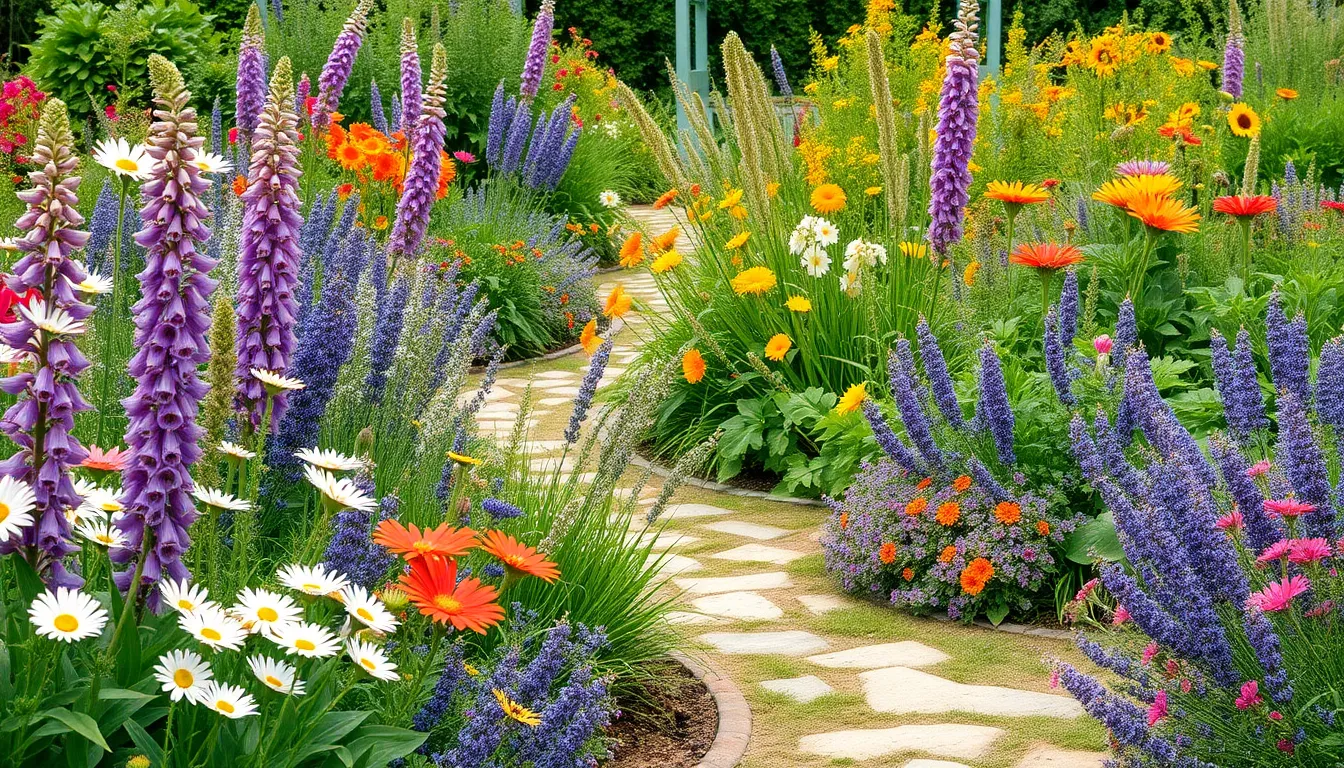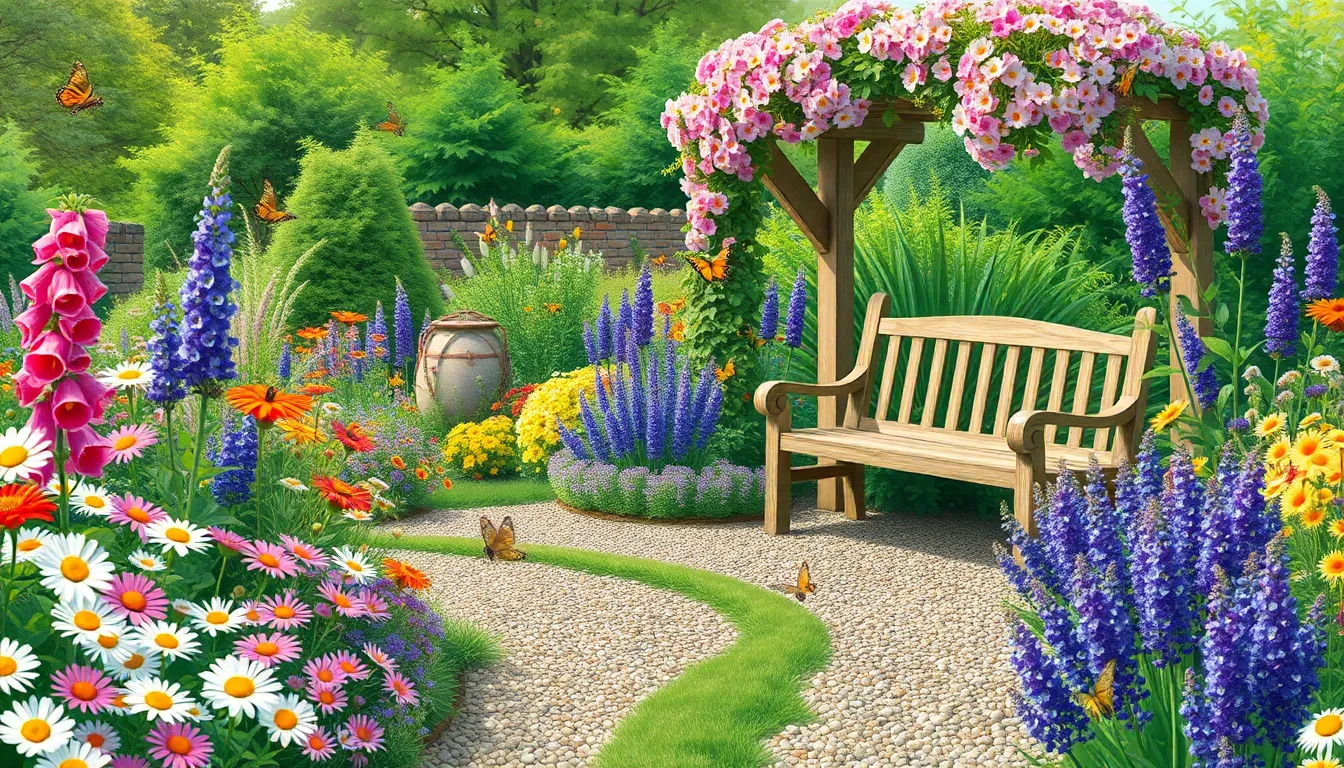Imagine stepping into a whimsical world where flowers dance in the breeze and vegetables are practically begging to be picked. Cottage garden design isn’t just about planting a few daisies and calling it a day; it’s an art form that combines beauty, functionality, and a touch of delightful chaos. This enchanting style invites nature to take center stage, creating a vibrant tapestry of colors and scents that make even the grumpiest neighbor crack a smile.
Whether you’re a seasoned gardener or just someone who can keep a cactus alive, designing your own cottage garden can be a rewarding adventure. With its charming mix of perennials, annuals, and herbs, this approach allows for creativity to flourish. So grab your gardening gloves and let’s dig into the delightful world of cottage garden design—where every flower has a story, and every garden is a little piece of paradise.
Cottage Garden Design
Cottage garden design emphasizes a charming, informal aesthetic that promotes productivity and biodiversity. This gardening style integrates a mix of colorful flowers, practical herbs, and perennial plants, creating a delightful tapestry of textures and scents. Vibrant blooms attract various pollinators, fostering a thriving ecosystem that enhances overall beauty.
An abundance of plant varieties typifies cottage gardens. Gardeners often select species that bloom at different times, ensuring continuous color throughout the seasons. Popular choices include lavender, foxglove, hollyhocks, and daisies, each contributing its unique character to the landscape.
Creative layouts characterize this garden style. Curved pathways lead wanderers through lush greenery, while ornamental objects, like trellises and birdbaths, add focal points. These elements encourage exploration, while also promoting a sense of tranquility.
Planting in clusters rather than neat rows enhances visual interest. Close proximity allows plants to flourish through mutual support, resulting in healthier growth. Gardeners appreciate the charming chaos that this method encourages, bringing a relaxed atmosphere to outdoor spaces.
Utilizing native plants presents distinct benefits in cottage garden design. Native species require less maintenance and are more resilient to local pests. This choice supports local wildlife while creating a sustainable gardening environment.
Overall, cottage garden design presents an exciting opportunity. It invites experimentation and personalization, empowering gardeners to express their unique styles. Those drawn to this approach enjoy creating harmonious, picturesque landscapes that inspire joy and connection to nature.
Key Elements Of Cottage Gardens

Cottage gardens thrive on diversity and charm, creating an inviting atmosphere filled with color and fragrance. Key elements include carefully chosen plants and thoughtfully designed pathways.
Plants And Flowers
Perennials, annuals, and herbs form the backbone of cottage gardens. Colorful flowers like daisies, foxgloves, and hollyhocks lend vibrancy and attract pollinators. Herbs such as lavender and chives not only add beauty but also serve practical purposes in cooking. Grouping plants together rather than in rows enhances visual appeal and promotes healthier growth through companion planting. Seasonal variety guarantees blooms throughout the year, establishing an evolving tapestry that symbolizes the essence of a cottage garden.
Pathways And Layout
Curved pathways invite exploration, leading visitors through a scenic journey. Natural materials like gravel or bricks often frame pathways, providing a rustic feel and enhancing the overall aesthetic. Organic shapes contrast sharply with rigid, formal gardens, emphasizing informality. Garden beds flow into one another, creating a cohesive look that encourages wildlife. Decorative elements like arbors or rustic benches enrich the landscape, offering spots for rest and reflection. Each pathway and layout choice contributes to a peaceful and engaging experience in the garden.
Designing Your Own Cottage Garden
Designing a cottage garden invites creativity and personal expression. Gardeners can curate lush spaces that reflect their unique tastes.
Choosing The Right Plants
To create a vibrant cottage garden, select a diverse mix of plants. Perennials provide stability, while annuals add seasonal splashes of color. Popular choices include lavender, daisies, and foxgloves, which attract pollinators. Herbs like rosemary and thyme offer functionality, enhancing culinary experiences. Grouping plants based on their height, color, and bloom time fosters visual interest. Combining different textures enriches the garden’s thematic appeal. Aiming for continuous blooms throughout the seasons ensures an evolving landscape. Diversity in plant selection nurtures biodiversity while contributing to the garden’s charm.
Creating A Cozy Layout
Creating a cozy layout transforms the garden into a welcoming retreat. Start with meandering paths that encourage exploration. Curved walkways enhance the informal aesthetic while guiding visitors through the space. Materials like gravel or reclaimed bricks establish a rustic feel. Incorporating sitting areas with benches or arbors invites relaxation, allowing for moments of reflection. Arranging plants in clusters rather than in rows enhances the overall appeal. Thoughtful placement of taller plants at the back creates a natural layering effect. Emphasizing a relaxed and intimate atmosphere encourages wildlife and adds warmth to the garden.
Maintenance Tips For Cottage Gardens
Cottage gardens require regular care to maintain their vibrant, chaotic beauty. Watering remains essential, especially during dry spells. Deep, infrequent watering promotes deep root growth, which supports plants during challenging weather. Mulching around plants conserves moisture and suppresses weeds, contributing to a healthier garden environment.
Pruning plays a crucial role in maintaining plant vigor. Regularly deadheading spent flowers encourages continuous blooming, while cutting back overgrown plants prevents overcrowding. Fertilizing with organic compost enriches the soil, enhancing fertility and promoting robust growth. Applying a balanced fertilizer in spring supports active growth phases for perennials and annuals.
Weeding must occur frequently to reduce competition for nutrients. Hand-pulling or using a hoe minimizes disturbances to established plants and the surrounding soil. Monitoring for pests maintains plant health too. Companion planting, a key strategy in cottage gardens, naturally deters pests while attracting beneficial insects.
Seasonal clean-up of debris like fallen leaves helps prevent diseases and pests from overwintering. Collecting and composting plant materials can enhance soil health for future growth. Observing plant performance throughout the seasons aids in identifying any struggling varieties. Adjusting plant selections based on these observations can lead to more resilient growth.
Regularly assessing pathways ensures safe access throughout the garden and preserves its aesthetic charm. Repairing any worn or damaged sections promotes longevity and enhances the overall look. Applying these maintenance tips transforms a cottage garden into a thriving, efficient ecosystem. Each action taken contributes to a colorful and inviting landscape, ensuring enjoyment for years to come.
Conclusion
Cottage garden design offers a unique opportunity to blend creativity with nature. Its informal charm invites gardeners to explore diverse plant combinations and layouts, creating vibrant spaces that uplift the spirit. By incorporating a variety of flowers, herbs, and textures, one can establish a living tapestry that attracts pollinators and enhances biodiversity.
With thoughtful design and regular maintenance, these gardens can flourish throughout the seasons. The emphasis on personal expression allows each gardener to cultivate a space that reflects their individual style. Embracing the whimsical nature of cottage gardens transforms outdoor areas into cozy retreats, fostering a deeper connection to the natural world.

